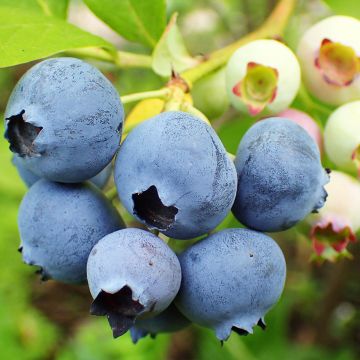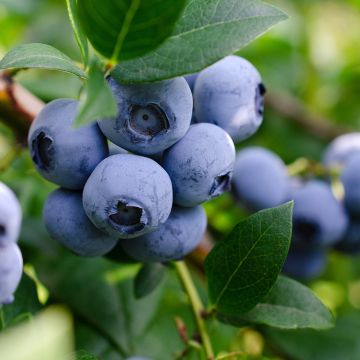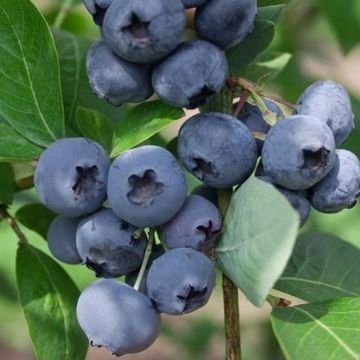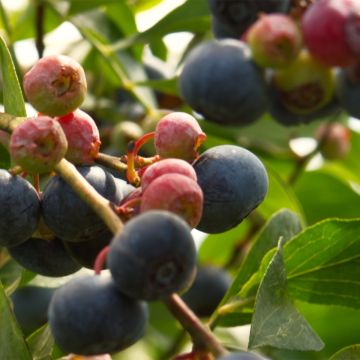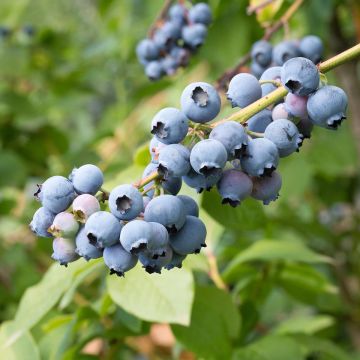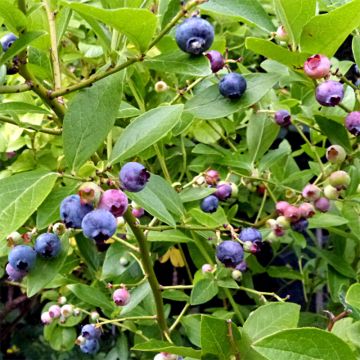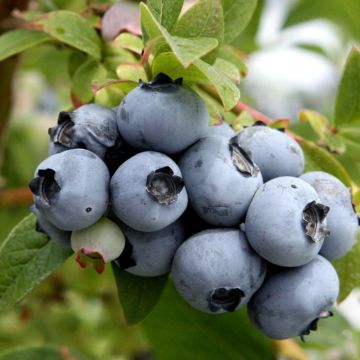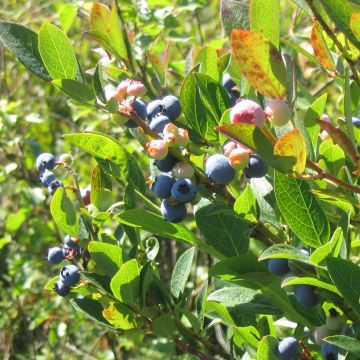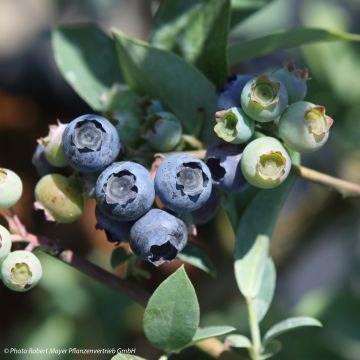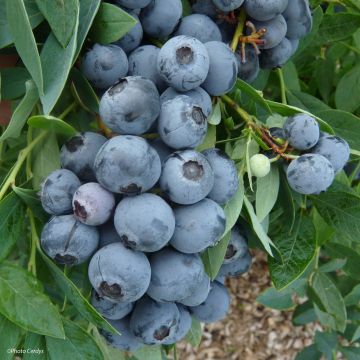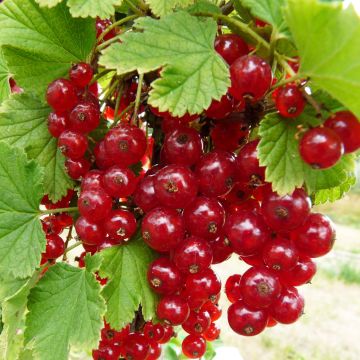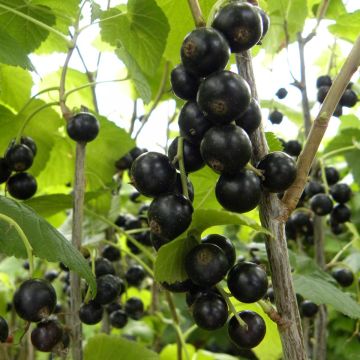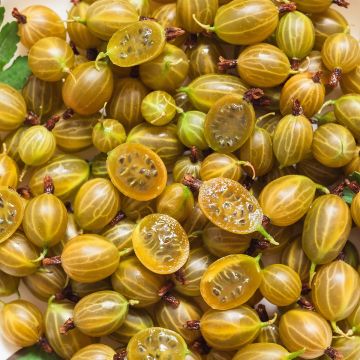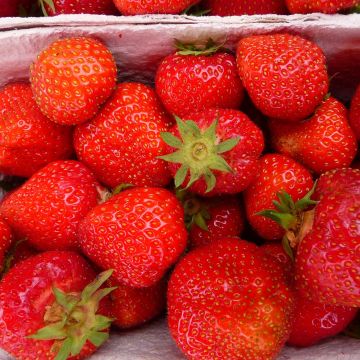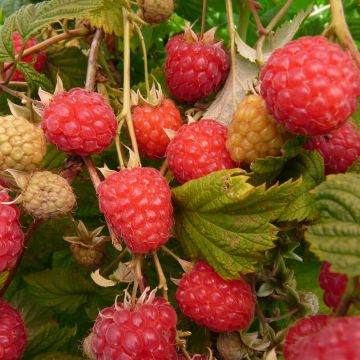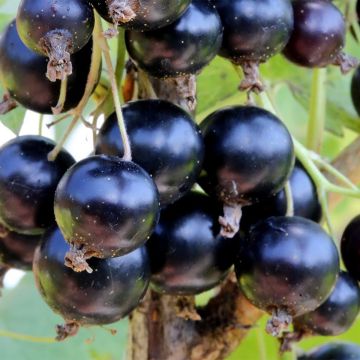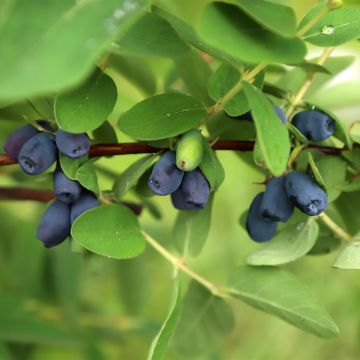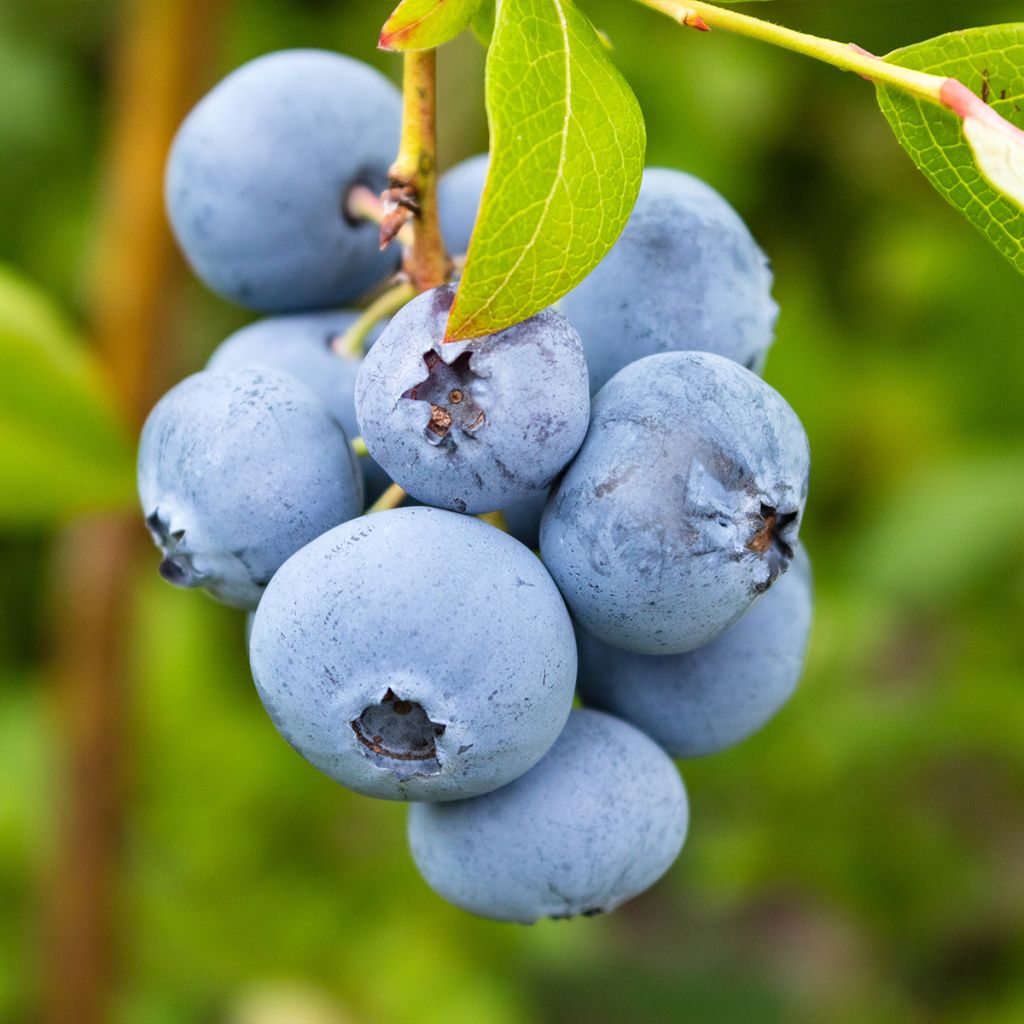

Vaccinium corymbosum Rubel- American Blueberry
Vaccinium corymbosum Rubel- American Blueberry
Vaccinium corymbosum Rubel
American Blueberry, Highbush Blueberry
This item cannot be shipped to the selected country
Delivery charge from €6.90
Delivery charge from €6.90
More information
Delivery charge from €6.90
Delivery charge from €6.90
More information
Schedule delivery date,
and select date in basket
This plant carries a 6 months recovery warranty
More information
We guarantee the quality of our plants for a full growing cycle, and will replace at our expense any plant that fails to recover under normal climatic and planting conditions.
From €7.90 for pickup delivery and €6.90 for home delivery
Express home delivery from €8.90.
From €7.90 for pickup delivery and €6.90 for home delivery
Express home delivery from €8.90.
Description
Vaccinium corymbosum 'Rubel' is a fairly vigorous variety, with faster growth than other Blueberries. This mid-season variety is very productive, producing pretty little flowers in May that develop into dark blueberries, ready to be harvested in August. They are highly concentrated in antioxidants. Like most American Blueberries, its foliage turns beautiful shades of red and orange in autumn. Although self-fertile, fruiting will be better if other varieties are planted nearby.
The Blueberry Bush belongs to the Ericaceae family, known in gardens for its many ornamental genera. The shrubby Blueberry (Vaccinium corymbosum), native to North America, is the one cultivated in gardens for its abundant and high-quality fruiting. It is a very hardy shrub, with deciduous foliage that colours beautifully before falling in autumn. It is grown in very acidic soil (not tolerant of limestone), in a semi-shaded position, for example in the morning sun.
The 'Rubel' variety was obtained in 1912 in the United States, in New Jersey. It is a very productive variety with consistent yields, known for having the highest concentration of antioxidants: about double that of other varieties! It is a relatively fast-growing shrub compared to other varieties, with an upright and rather dense habit, which explains the good yield despite the small size of the fruit. It reaches up to 1.80m (6ft) in height and 1m (3ft) to 1.20m (4ft) in width, and its foliage consists of elliptical and pointed leaves of a fairly dark green colour. Its branches take on magnificent autumnal colours, mostly in shades of red or orange, which, in addition to its production of small fruits, makes it a decorative shrub at the end of the season. Flowering takes place in May, in the form of small white bells, 0.5 to 1 cm long, gathered in pendulous clusters 2 to 5 cm (1 to 2in) long, at the end of the stems. They develop into small berries of a very dark blue colour, almost black, which are also decorative - until they are harvested, of course. These small-sized berries are spherical in shape and usually ripen in the first half of August. Firm, they have a sweet taste, slightly acidic, and are very aromatic. This variety reaches maturity after 4 to 5 years.
Blueberries are low in calories but high in nutritional value: they are very rich in vitamins A, B, and C, calcium, and iron. They contain pigments (anthocyanins) that improve night vision. Their many qualities earn them the title of superfood, especially this variety, which is particularly rich in antioxidants. Rubel berries can be consumed freshly picked or cooked, especially in pastries (pies, muffins etc.). The fruit can be stored for about ten days after picking and can be frozen for longer preservation.
You can plant 'Rubel' together with other varieties of Vaccinium corymbosum if you want to ensure beautiful harvests. For variety, plant the Aronia prunifolia Nero nearby, a shrub of comparable size that produces edible black fruits in October and also colours beautifully in autumn. You can also incorporate your Blueberry plants into a diverse bed of ornamental ericaceous plants. At the edge of the bed, plant Callunas, or Summer Heather, such as 'Winter Chocolate', a surprising variety with purple flowers from August to October and foliage that changes colour with the seasons. It will create a beautiful contrast with the dark green foliage of Rubel. And if the size of your bed allows, provide it with some shade by planting a Cercidiphyllum japonicum, the caramel tree (it's not a legend, on some days at the end of the season, it actually emits this characteristic smell). Its beautiful heart-shaped foliage becomes multicoloured in autumn, it's a splendour.
Vaccinium corymbosum Rubel- American Blueberry in pictures


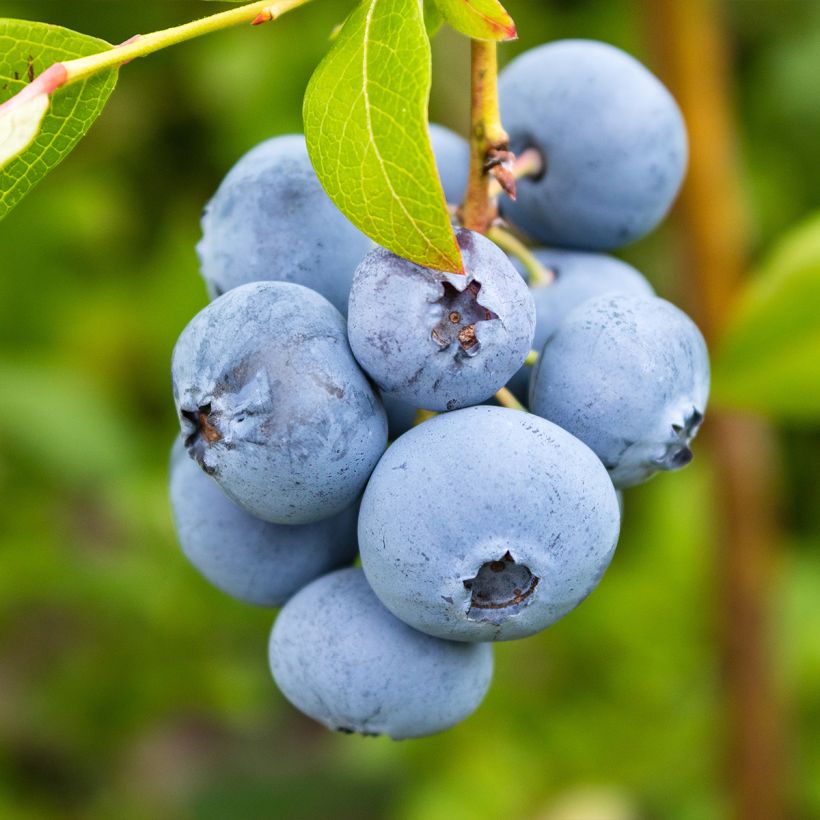

Plant habit
Fruit
Flowering
Foliage
Botanical data
Vaccinium
corymbosum
Rubel
Ericaceae
American Blueberry, Highbush Blueberry
Cultivar or hybrid
Other Blueberry bush
View all →Planting and care
Planting the Blueberry Bush ideally takes place in autumn or throughout the year, avoiding frost and heatwaves. This bush should be planted in the sun (not scorching) in cooler regions and strictly in partial shade in hotter southern ones. If you plant multiple bushes, space them 1.20m (4ft) apart in all directions. This Blueberry Bush is very hardy: -20°C (-4°F) and below for the plant, but the flowers can be damaged below -5°C (23°F), and has a particularly long lifespan.
Plant it in a highly acidic soil (pH between 4 and 5.5), incorporating pure ericaceous soil, or in a mixture of regular soil and peat, well-decomposed bark compost. The collar (the point where the trunk meets the roots) should be level with the ground. Firmly press down the soil and water generously with non-limestone water. In slightly calcareous soil, dig a hole 50 to 60cm (20 to 24in) deep, line the edges with garden felt, place a 10cm (4in) layer of non-limestone gravel at the bottom, then fill with a mixture of compost and ericaceous soil.
The soil should remain moist but not waterlogged: the plant tolerates moderate drought and avoids stagnant moisture. If watering is necessary, use non-limestone and non-chlorinated water (e.g. rainwater collection). Mulch the base with shredded bark, straw, or fern leaves. It is sometimes useful to put up a protective net if birds become too greedy during harvest time. In spring, annually apply some well-rotted compost on the surface. The Blueberry Bush is not very susceptible to diseases and pests.
Planting period
Intended location
Care
-
, onOrder confirmed
Reply from on Promesse de fleurs
Berries
Haven't found what you were looking for?
Hardiness is the lowest winter temperature a plant can endure without suffering serious damage or even dying. However, hardiness is affected by location (a sheltered area, such as a patio), protection (winter cover) and soil type (hardiness is improved by well-drained soil).

Photo Sharing Terms & Conditions
In order to encourage gardeners to interact and share their experiences, Promesse de fleurs offers various media enabling content to be uploaded onto its Site - in particular via the ‘Photo sharing’ module.
The User agrees to refrain from:
- Posting any content that is illegal, prejudicial, insulting, racist, inciteful to hatred, revisionist, contrary to public decency, that infringes on privacy or on the privacy rights of third parties, in particular the publicity rights of persons and goods, intellectual property rights, or the right to privacy.
- Submitting content on behalf of a third party;
- Impersonate the identity of a third party and/or publish any personal information about a third party;
In general, the User undertakes to refrain from any unethical behaviour.
All Content (in particular text, comments, files, images, photos, videos, creative works, etc.), which may be subject to property or intellectual property rights, image or other private rights, shall remain the property of the User, subject to the limited rights granted by the terms of the licence granted by Promesse de fleurs as stated below. Users are at liberty to publish or not to publish such Content on the Site, notably via the ‘Photo Sharing’ facility, and accept that this Content shall be made public and freely accessible, notably on the Internet.
Users further acknowledge, undertake to have ,and guarantee that they hold all necessary rights and permissions to publish such material on the Site, in particular with regard to the legislation in force pertaining to any privacy, property, intellectual property, image, or contractual rights, or rights of any other nature. By publishing such Content on the Site, Users acknowledge accepting full liability as publishers of the Content within the meaning of the law, and grant Promesse de fleurs, free of charge, an inclusive, worldwide licence for the said Content for the entire duration of its publication, including all reproduction, representation, up/downloading, displaying, performing, transmission, and storage rights.
Users also grant permission for their name to be linked to the Content and accept that this link may not always be made available.
By engaging in posting material, Users consent to their Content becoming automatically accessible on the Internet, in particular on other sites and/or blogs and/or web pages of the Promesse de fleurs site, including in particular social pages and the Promesse de fleurs catalogue.
Users may secure the removal of entrusted content free of charge by issuing a simple request via our contact form.

































